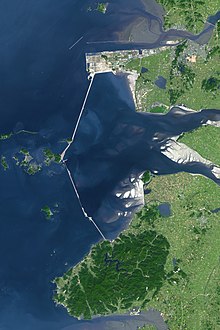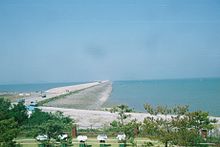Saemangeum
| Korean spelling | |
|---|---|
| Korean alphabet : | 새만금 |
| Hanja : | 새 萬 金 |
| Revised Romanization : | Saemangeum |
| McCune-Reischauer : | Saeman'gŭm |
The Saemangeum was a wadden sea in South Korea . In April 2006, a long contested dam was completed, which is intended to convert the former Wadden Sea into an agricultural and industrial area. The area is located on the South Korean west coast at the mouth of the Dongjin-gang and Man-gyeonggang rivers between the two cities of Gunsan and Buan . It is part of the Yellow Sea .
With an area of 400 square kilometers, the Saemangeum Wadden Sea, together with the Minas Basin on Fundy Bay in Canada, was one of the largest Wadden Sea after the North Sea Wadden Sea .
The Wadden
The bottom of the Saemangeum Wadden Sea was subject to the influence of the tides , so that it fell dry twice a day at low tide . The area that has fallen dry is called the watt.
There are different types of mudflats . The sand mud flats, the mixed mud flats and the silt mud flats. The mudflats of the Saemangeum Wadden Sea ( 새만금 갯벌 ) had a dense vegetation of diatoms .
Flora and fauna
The landscape of the Saemangeum Wadden Sea offered a habitat for well over 600 different animal species . About 200 of these species lived in the tidal area , more than 400 other species in the permanently flooded area.
Until the construction of the dike, the Saemangeum Wadden Sea was the most important resting place for migratory birds in East Asia, which breed in Siberia and overwinter in Australia . This included 30 different plover species. This Wadden Sea represented an important wintering area for the critically endangered spotted green leg , and for the endangered sandpiper , whose population has declined to 2,000 animals, the Saemangeum Wadden Sea is even the only known resting place.
Saemangeum Dam
Since the beginning of the 1990s , the South Korean government intended to dike the Saemangeum Wadden Sea in order to reclaim land . The dike was completed in April 2006. This large embankment measure with a dyke length of 33 kilometers destroyed large parts of the natural area.
resistance
Environmental organizations and parts of the population tried to avert the project. The opponents tried to stop the project with lawsuits. In July 2003 they obtained the temporary suspension of construction by the South Korean administrative court. However, in January 2004 the Supreme Court decided to continue the construction work.
consequences
The maximum tidal range decreased from 7 to 1 meter after the dam was completed. In April 2007, a large part of the former tidal flats was destroyed. The areas were either permanently flooded or dried up.
The Wadden Sea was an important resting place for migratory birds. While more than 198,000 birds were counted in April and May of 2006, in 2007, a year after the dam was completed, it was only 88,000.
industrial area
A large industrial area is emerging in the north of the new land. The OCI Company built a 303 MW combined cycle power plant by 2016 . Companies such as Toray also settled here .
Footnotes
- ↑ Dominic Couzens: Rare Birds - Survivors, Evolution Losers and the Lost. Haupt Verlag, Bern 2011, ISBN 978-3-258-07629-4 , p. 88.
- ^ The dike construction in Saemangeum and its opponents. on: lighthouse-foundation.org
- ↑ a b Martin Wolf: Stay up there? Considerations in the run-up to the (Water) Expo in Yeosu 2012 , in: Blickpunkt Asia Pacific 10/2011.
- ↑ OCI to invest $ 3 bil. in new biz . In: Korea Times . October 21, 2013 ( online ).
- ↑ Japan's Toray completes factory in Saemangeum . In: Yonhap News Agency . July 16, 2016 ( online ).
Web links
- Birds Korea South Korean environmental protection organization
- Lighthouse Foundation map - illustration of the planned use of the area gained.
- Lighthouse Foundation - critical side to dyke construction
Coordinates: 35 ° 49 ' N , 126 ° 37' E



